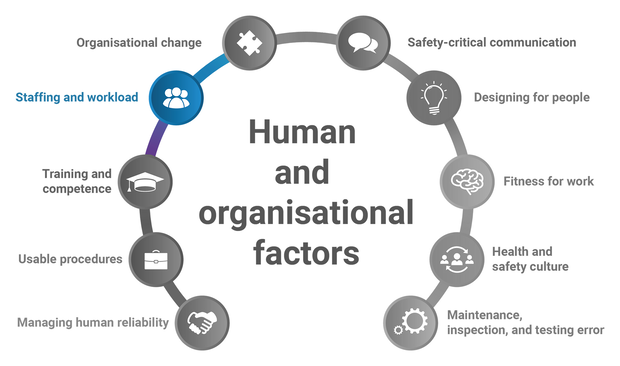
What are staffing and workload?
Ensuring appropriate staffing and workload is critical to maintaining a safe workplace.
Staffing is often described as ‘having the right people in the right place at the right time’. However, ensuring appropriate staffing levels is not just a matter of having enough staff, but also ensuring that they have suitable knowledge, skill and experience to operate safely.
Workload refers to the physical or cognitive effort required to carry out a task. It is important to consider both the physical and mental workload required for tasks when determining what is expected from workers, and to make sure that these expectations are reasonable given human capabilities and limitations.
High workload and inadequate staffing can cause fatigue and adversely affect decision making. They are known contributory causes of many safety incidents.
One way to effectively manage workload is to ensure appropriate staffing levels.
Staffing
Staffing levels, meaning both the number of people and skill sets required, should be matched to the volume of work. Adverse changes to staffing are typically the result of organisational change, highlighting the need for proper consideration of staffing levels to be factored into any organisational changes that are planned.
Reduced staffing levels usually result in reduced capacity to manage increases in workload, particularly when work processes are not reorganised to account for the reduced number of people available. This has a number of consequences, which not only affects the organisation, but also the health and safety of the worker. These can include:
- loss of competency
- inadequate supervision and increased practice of staff working alone
- more overtime, which may impact on fatigue management
- increased sick leave and absenteeism
- decreased job satisfaction and morale
- overlooking organisational health and safety considerations.
Staffing levels may be inadequate if there are:
- increases in rates of safety incidents
- safety-critical tasks not being completed or completed later than they should be
- maintenance backlogs
- increases in overtime being required to meet operational targets
- increased complaints and absences due to stress, fatigue or other ill-health
- increases in staff turnover, absenteeism and presenteeism
- emerging breakdowns in communication.
Organisations should understand the key drivers of workload and be aware of the need to optimise staffing levels. They should be aware that, without proper consideration of the likely impact on workload, small gradual changes can add up unnoticed.
To ensure appropriate staffing, organisations should maintain sufficient staff numbers to carry out all required tasks. This means:
- considering, when downsizing, how all functions are to be carried out effectively by remaining staff without overloading them
- maintaining sufficient staffing levels for emergency situations which may require more personnel than under normal conditions, and confirm that personnel have the skills to carry out their emergency role
- considering contingencies in the event of illness, emergency work and times of peak workloads
- providing training to reduce the risk of non-competent workers conducting tasks
- ensuring that the span of control of employees in supervisory positons is appropriate.
Workload
The workload of a task can either be mental, physical or a combination of both.
Physical workload refers to the physical effort required to carry out a task. Some tasks have a high physical workload such as lifting, carrying, pushing, pulling, or other sustained effort, or a large number of physical tasks that have to be done in a given timeframe. Working in a cramped or restricted environment can also add to physical workload as can climbing ladders and working at heights.
Mental workload refers to the mental, or cognitive, effort required to carry out a task. It varies across tasks, with some demanding more of our cognitive resources than others.
Tasks with high physical workload can result in fatigue, injury or illness, or the inability to work any longer. In order to determine a worker’s ability to complete the physical requirements of a job, a task analysis of the physical components of the job should be completed. Workers expected to do the job should undergo a functional capacity assessment to ensure they are able to complete the work safely.
As with any other type of work, good job design should be employed for physical work with human ergonomics, capabilities and limitations in mind. This means setting up the work environment and work processes in such a way that the physical work is not detrimental to worker health.
Situations that include any of the following require a high mental workload:
- diagnosing a problem and developing an effective solution, especially where the problem is complex or there are multiple problems to solve
- processing multiple sources of information and making difficult decisions
- applying fine judgement
- remembering or recalling lots of facts or pieces of information
- applying sustained attention or vigilance
- maintaining a high level of situational awareness of both the current state of the situation and the correct response if the situation changes.
Conducting risk assessments or task observations can assist organisations to identify, measure and bring situations where the cognitive workload is high, under control.
Tasks with combined high physical and cognitive workload become more demanding if:
- they are performed under time pressure or have to be sustained over a long period of time
- workers are required to multi-task
- workers are not yet fully competent in the tasks (e.g. they have not been able to practice the skills acquired)
- they are conducted in unusual or emergency situations
- information available is unclear or ambiguous, provided late, or requires some form of conversion or processing
- the result of the activities are critical to safety, environmental protection or financial success
- the worker is fatigued or distracted
- workers are not fit for work (mentally or physically) and are therefore unable to perform effectively in their roles.
Resources
|
This document from the UK Keil Centre discusses various aspects related to staffing levels. |

